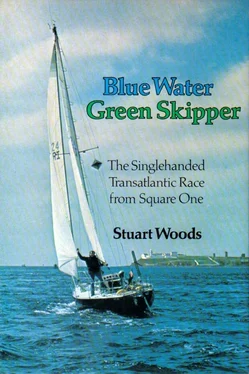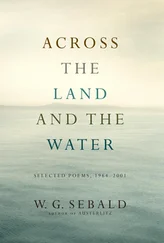Lloyd seemed to feel that no matter what the committee decided, they would be criticized, so they would simply press on, organizing the race the way they felt it should be done.
We left the Royal Western and had a look at the place where all the OSTAR yachts would congregate in late May. Millbay Docks is a large, concrete tidal basin with locks which open an hour before every high tide and close an hour afterward. It is surrounded by businesses and warehouses, most of which have something to do with shipping or ships and, apart from its size, is not a very impressive place. It is doubtful if the place has ever been drained and cleaned, and there is a story that once, when someone fell into the water, he was, after having his stomach pumped out, detained for forty-eight hours in a hospital for observation. I do not doubt it.
We drove over to the Mayflower Marina and were given a tour of the facilities there, and I booked Harp in for the week prior to the deadline for being in Millbay Docks. Finally, we visited Alec Blagdon’s boatyard, and I made arrangements for a haulout in case it was necessary before the race. Alec Blagdon is a kindly man with a West Country accent, and we shared mutual friends in Cork. I felt he would be very helpful if I should need it.
I had hoped to take Ann sailing, but on our return to Cork found that the yard still had not finished with Harp. A couple of young American students turned up, sent along by Bill King, and I put them to work rubbing and antifouling the yacht’s hull. Eventually, we got her in the water. At last she seemed right. I was certain that a lot of detail would still need work, but she was basically watertight and sound. Her keel had been removed, a reinforced glass-fiber “shoe” inserted between the keel and the hull, and the keelbolts glassed in. This stopped the movement of the keel which had loosened the bolts and allowed water to come into the boat. The Brookes & Gatehouse log hull fitting had been replaced, the first one having been incorrectly installed; lockers had had floors glassed into them to keep bilge water from entering; the port pilot berth had been enclosed to make a clothing locker — now the heater radiator would warm two dry lockers as well as the boat; a beam had been glassed under the deck to reinforce the inner forestay deck fitting; a padeye had been fitted to the foredeck and bolted to a bulkhead — I could now set a small storm jib flying without taking down the headsail, just roller-reefing it; the interior of the cabin had been relined with foam-backed vinyl; the windows had been removed, resealed, and bolted on; a new Sestrel Porthole compass had been fitted, which could be read both from the cockpit and from the cabin; all the deck blocks had been removed, resealed, and refitted; the decks had been given a new and better nonslip finish; and a dozen other small refinements had been made.
She was mine again. Mine. I had six weeks to get her ready for a May 15th departure for Plymouth. Harry McMahon and I would take a leisurely week to sail her there, the last unhurried time I would have aboard her. I looked forward to it eagerly.
21
A last Irish Spring and final preparations
That there was much more work to be done on the boat became clear the first time I sailed her. Some friends and I set off for a weekend cruise to Kinsale, and as we were sailing out of Cork Harbor one of the girls asked for a sponge and bucket to do some bailing. Thinking that a little water had been left in the bilges I handed down the bucket, but a couple of minutes later, as Harp heeled in a gust, there came a shout from below that water was pouring into the boat. I jumped down the companionway ladder to find a heavy stream of water entering the cabin from the engine bay. I got the ladder and engine bulkhead off and found a bare-ended hose pouring water into the boat at the rate of about twenty gallons a minute. Fortunately, a wine cork was the perfect size to plug the hose, and with a jubilee clip tightened around the whole thing, it seemed watertight. But we canceled the cruise to Kinsale and settled for a sail around Cork Harbor, uncertain what other defects we might find.
Harold Cudmore and I planned to sail up to Galway, to arrive in time for the West of Ireland Boat and Leisure Show, now a fixture of the Galway Bay Sailing Club. O.H. and I sailed the boat as far as Kinsale, from where Harold and I would depart for the long cruise down the southwest coast, then around the corner and up the west coast to Galway, but we began to get bad weather forecasts for the west coast and I decided to drive. We left the boat on a mooring at Kinsale, for collection later. A couple of days afterward I was awakened at eight in the morning by the ringing of the telephone. (After six months of clawing my way through the Irish Civil Service, I had finally got a phone by appealing to a politician friend, who wrote one letter and did the trick.) A voice asked if I was the owner of Golden Harp. I was. She had broken her mooring and was aground on the opposite bank of the river.
I dressed and made the fourteen miles to Kinsale in record time, my heart in my mouth and pictures running through my mind of Harp lying on her topsides, her mast tangled in some tree. I arrived to find that Courtney Good, a Kinsale businessman and owner of another Shamrock, had pulled her off with the club crashboat, and we got her onto another mooring quickly, completely undamaged. It had been the scare of my life, for if she had been damaged badly I would have had one hell of a time getting her right again in time for the race. I sailed her back alone in a Force seven, but it being an offshore breeze the sea was flat. It was only the second time I had sailed her single-handed, and it was very exhilarating.
I drove up to Galway for the boat show, which was bigger and better than ever, and for a last goodbye to the people who had given me my first opportunity to sail, both in dinghies and cruising boats. At the dinner, I was allowed to say a few words, and I presented a cup to the club to be given each year for the best cruise by a member. I was very sad to think that I might not see Galway or any of my friends there for a very long time.
Some time in April I read that there was a second Irish entry in the OSTAR, Patrick O’Donovan, and that he had just sailed into Kinsale at the completion of his qualifying cruise in a thirty-one-foot trimaran. The next day I was invited to dinner at the O’Donovans’ Cork home, where Patrick and I got acquainted and compared notes on our preparations. He mentioned a new marine radar detector which would sound an alarm in the presence of radar signals from another ship, and this sounded a good idea, since the OSTAR rules prohibited radar on the yachts participating. I ordered one immediately.
Patrick had had his problems with getting a boat ready and would have more. He had planned to sail Lillian, a fifty-five-foot proa, in the race, and had actually qualified in her, but on a return trip from Ireland to England with Lillian ’s owner, the proa had capsized in a Force ten and Patrick and the owner had spent eighteen hours in the life raft, tied between the proa’s floats, until they were picked up by a fishing vessel. When they returned to look for Lillian she could not be found, and they learned subsequently that she had been taken as salvage by a Russian ship, sawn into manageable pieces, and left on a quayside in Cairo, of all places. All Patrick had got back was his passport, forwarded by the British consulate there. Now he had bought my friend David Walsh’s trimaran, Silmaril, and qualified her. The following morning he stopped by Drake’s Pool for a look at Harp and more conversation. Patrick, who was only twenty-three, would be one of the youngest competitors in the race. Born in Cork, he was now living in England and was preparing his boat there.
Читать дальше












